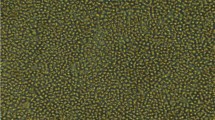Abstract
Sulfur mustard is a waemical warfare blistering agent for which neither the mechanism of action nor an antidote is known. Papirmeister et al. (1985) have postulated a biochemical hypothesis for mustard-induced cutaneous injury involving a sequelae of DNA alkylation, metabolic disruption and activation of protease. Human peripheral blood lymphocytes in cell cultures were employed as an in vitro model for alkylating agent toxicity. A chromogenic peptide substrate assay was used for detection of protease in lymphocytes treated with sulfur mustard or chloroethyl ethyl sulfide. Exposure of human peripheral blood lymphocytes from normal donors to these alkylating agents resulted in an increase in cell associated protease activity. This increase in protease activity may contribute to the pathology or act as an indicator to predict methods of therapeutic intervention for sulfur mustard toxicity.
Similar content being viewed by others
Abbreviations
- PBL:
-
peripheral blood lymphocytes
- CEES:
-
chloroethyl ethyl sulfide
- DFP:
-
diisopropyl fluoro-phosphate
- pNA:
-
p-nitroaniline
- CPSPA:
-
Chromogenic Peptide Substrate Protease Assay
References
ANSLOW, W.P. and HOUCK, C.R. (1946). Systematic pharmacology and pathology of sulfur and nitrogen mustards. In NRDC report, Chemical Warfare Agents and Related Chemical Problems, Division 9, Washington, D.C. pp.440–479
BRDAR, B. (1986). Introduction of plasminogenactivator by alkylating agents in a repair defective human glioblastoma cell strain. 46:2282–2284.
CAPPIZZI, R.L., SMITH, W.J., and PAPIRMEISTER, B. (1973). A host-mediated assay for chemical mutagens using the L5178Y/Asn(-) murine leukemia. Mutat. Res. 21:6.
COOPER, T.W., BAUER, E.A., and BRIGGAMAN, R.A. (1987). The mechanobullous disease (Epidermolysis bullosa). In: Dermatology in General Medicine. (T.B. Fitzpstrick, A.Z. Eizen, and K. Wolff, eds). Vol. 3, pp.610–626. McGraw-Hill, New York.
FOX, M. and SCOTT, D. (1983). The genetic toxicology of nitrogen and sulfur mustards. Mutat. Res. 75: 131–168.
FRIBERGER, P. (1982). Chromogenic peptide substrates. J. Clin. Lab.Invest. 42 (Suppl 162):1–98.
HIGUCHI, K., KAJIKI, A., NAKAMURA, M., HARADA, S., PULA, P.J., SCOTT, A.L., and DANENBERG, A.M..(1988). Protease released in organ culture by acute inflammatory lesions produced in vitro in rabbit skin by sulfur mustard: Hydrolysis of synthetic peptide substrates for Trypsin-like and chymotrypsin-like enzymes. Inflammat. 12:311–334.
KAHL, F.R. and PEARSON, R.W. (1967). Ultrastructural studies of experimental vesiculation. I: Papain. J. Invest. Derm. 49:43–59.
KNUDSON, B.S. and NACHMAN, R.L. (1988). Matrix plasminogen activator inhibitor: Modulation of the extracellular proteolytic environment. J. Biol. Chem. 263:9476–9481.
MATSUMOTO, M. and HASIMOTO, K. (1986). Blister fluid from epidermolysis bullosa letalis induces dermal-epidermal separation in vitro. J. Invest. Dermatol. 87:117–121.
MEIER, H.L., GROSS, C.L., JOHNSON, J.B., GRAHAM, L.M., and LUSCO, C.T., (1986). The development of an in vitro model to determine the efficacy of prophylactic and therapeutic compounds for mustard injury. Proc of the NATO RSG-3, Panel VIII Meeting, Brussels.
MEIER, H.L., GROSS, C.L., and PAPIRMEISTER, B. (1987). 2,2′-dichlorodiethyl sulfide (sulfur mustard) decreases NAD+ levels in human leukocytes. Toxicol. Lett. 39:109–122.
MISKIN, R. and REICH, E. 1980. Plasminogen activator: Introduction of synthesis by DNA damage. 19:217–224.
NEURATH, H. and WALSH, K.A. (1977). The role of proteases in physiological regulation: An overview. FEBS Proc. 47:1–14.
OORENIUS S. and NICOTERA, P. On the role of calcium in toxicity. (1987). Arch. Toxicol. Suppl. 11: 11–19.
PAPIRMEISTER, B. and DAVISON, C.L. (1965). Unbalanced growth and latent killing of Escherichia coli following exposure to sulfur mustard. Biochem. Biophys. Act. 103:70–92.
PAPIRMEISTER, B., GROSS, C.L., MEIER, H.L., PETRALI, J.P., and JOHNSON, J.B. (1985). Molecular basis for mustard-induced vesication. Fund. and Appl. Toxicol. 5:S134-S149.
PAPIRMEISTER, B., GROSS, C.L., PETRALI, J.P. annd MEIER, H.L. (1984). Pathology produced by sulfur mustard in human skin grafts on athymic nude mice. II: Ultrastructural changes. J. Toxicol. Cutan. and Ocular Toxicol. 3:395–410.
PARANJPE, M., ENGEL, L., YOUNG, N., and LIOTAA, L.A. (1980).Activation of human breast carcinoma collagenase through plasminogen activator. Life Sci. 26:1223–1231.
RENSHAW, B. (1946). Mechanisms in production of cutaneous injuries by sulfur and nitrogen mustards. In MRDC report, Chemical Warfare Agents and Related Chemical Problems, Division 9, Washington, D.C. pp.479–512.
SANDERS, K.M., INNACE, J.K., GROSS, C.L., and SMITH, W.J. Flow cytotometric analysis of peripheral blood lymphocytes for the assessment of toxicity by alkylating agents. Alternative Methods in Toxicology Research. 7: 255–263, 1989.
SCHNYDER, J. and BAGGIOLINI, M. (1980). Induction of plasminogen activator secretion in macrophages by electrochemical stipulation of the herose monophosphate shunt with methylene blue. Proc Natl Acad Sci USA. 77:414–417.
SMITH, W.J., COWAN, F.M., and BROOMFIELD, C.A. (1991a). Increased proteolytic activity in human epiteelial cells following exposure to sulfur mustard. FASEB J 5: A828.
SMITH, W.J., SANDERS, K.M., GALES, Y.A., and GROSS, C.L. (1991b). Flow cytometric analysis of toxicity by vesicating agents in human cells in vitro. J. Toxicol. Cutan. and Ocular toxicol. 10 (1), (in Press)
SUGITA, K., SUZUKI, N., and NAKAJIMA, H. (1987). Enhancement of plasminogen activator activities by N-methyl-N-nitro-N-nitrosuguanidine in tuberous sclerosis fibroblasts. Mutation Res. 192:271–276.
TRAGER, F.C. (1991). [Letter] Chemical sencitivity. Chemical & Engineering News. 69:4.
WERB, A., MAINARDI, C.L., VATER, C.A., and HARRIS, E.D. (1977). Endogenous activation of latent collagenase by rheumatoid synovial cells. New Engl. J. Med. 296:1017–1023.
WHEELER, G.P. (1962). Studies related to the mechanism of action of cytotoxic alkylating agents. Cancer Res. 22: 651–688.
Author information
Authors and Affiliations
Additional information
The opinions or assertions herein are the private views of the authors and are not to be construed as official or as reflecting the views of the Department of the Army or the Department of Defense.
Rights and permissions
About this article
Cite this article
Cowan, F.M., Broomfield, C.A. & Smith, W.J. Effect of sulfur exposure on protease activity in human peripheral blood lymphocytes. Cell Biol Toxicol 7, 239–248 (1991). https://doi.org/10.1007/BF00250978
Received:
Accepted:
Issue Date:
DOI: https://doi.org/10.1007/BF00250978



